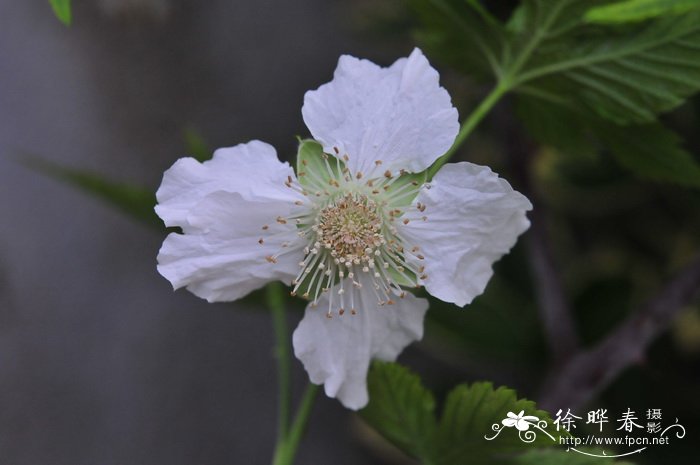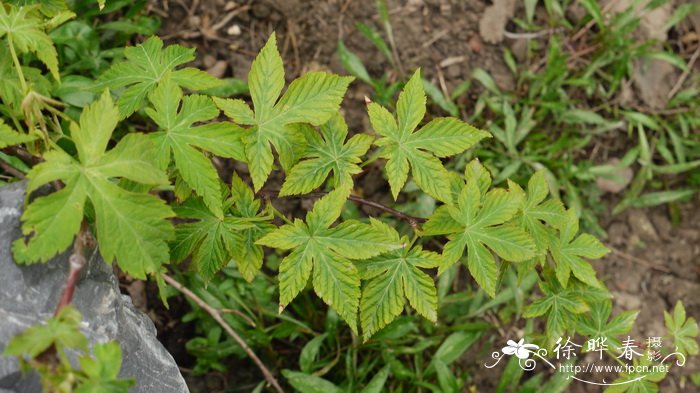掌叶覆盆子Rubus chingii
中文名(Chinese Name):掌叶覆盆子
学名(Scientific Name):Rubus chingii Hu
英文名(English Common Name):
别名(Chinese Common Name):号角公、牛奶母
异名(Synonym):Rubus officinalis Koidz. Rubus palmatus Hemsl. Rubus chungii Hu
科属(Family & Genus):蔷薇科(Rosaceae)悬钩子属
形态特征(Description):藤状灌木,高1.5-3米;枝细,具皮刺,无毛。单叶,近圆形,直径4-9厘米,两面仅沿叶脉有柔毛或几无毛,基部心形,边缘掌状,深裂,稀3或7裂,裂片椭圆形或菱状卵形,顶端渐尖,基部狭缩,顶生裂片与侧生裂片近等长或稍长,具重锯齿,有掌状5脉;叶柄长2-4厘米,微具柔毛或无毛,疏生小皮刺;托叶线状披针形。单花腋生,直径2.5-4厘米;花梗长2-3.5(4)厘米,无毛;萼筒毛较稀或近无毛;萼片卵形或卵状长圆形,顶端具凸尖头,外面密被短柔毛;花瓣椭圆形或卵状长圆形,白色,顶端圆钝,长1-1.5厘米,宽0.7-1.2厘米;雄蕊多数,花丝宽扁;雌蕊多数,具柔毛。果实近球形,红色,直径1.5-2厘米,密被灰白色柔毛;核有皱纹。花期3-4月,果期5-6月。
分布(Distribution):产江苏、安徽、浙江、江西、福建、广西,生低海拔至中海拔地区,在山坡、路边阳处或阴处灌木丛中常见。日本有分布。
用途(Use):果大,味甜,可食、制糖及酿酒;又可入药,为强壮剂;根能止咳、活血、消肿。
引自中国植物志英文版:FOC Vol. 9 Page 236
Rubus chingii H. H. Hu, J. Arnold Arbor. 6: 141. 1925.
掌叶复盆子 zhang ye fu pen zi| Rosaceae | Rubus
Shrubs lianoid, 1.5–3 m tall. Branchlets green when young, reddish brown in age, cylindric, slender, glabrous, with sparse prickles 5–6 mm and glaucous bloom. Leaves simple; petiole green, 2–4 cm, slightly pubescent or glabrous, with sparse prickles 5–6 mm; stipules green, linear-lanceolate, 7–10 mm, puberulous or glabrous; blade suborbicular, 5–11(–16) × 5–13(–18) cm, palmately (3–)5–7-veined, both surfaces pubescent or subglabrous, base cordate, margin usually palmately (3–)5(–8)-lobed; lobes elliptic to rhombic-lanceolate, terminal lobe slightly longer than lateral lobes, lobes contracted toward base, doubly serrate, apex acuminate to caudate. Inflorescences terminal on short branchlets, 1-flowered. Pedicel 2–3.5(–4) cm, usually glabrous. Flowers 2.5–4(–5) cm in diam. Calyx somewhat green or purplish red, abaxially densely pubescent; tube broadly pelviform; sepals narrowly ovate to ovate-oblong, 7–10 × 4–6 mm, apex acute to shortly acuminate, abruptly long pointed. Petals white, elliptic or ovate-oblong, rarely obovate, 1–1.5(–2.5) × 0.7–1.5 cm, glabrous, base shortly clawed, apex obtuse. Stamens many in 3 whorls, unequal in length, shorter than petals; filaments broad, complanate. Pistils numerous, shorter than longer stamens, nearly as long as shorter ones; ovary densely gray pubescent. Aggregate fruit red, subglobose, 1.5–2 cm in diam., densely gray pubescent; pyrenes rugose. Fl. Mar–Apr, fr. May–Jun. 2n = 14.
Slopes, broad-leaved evergreen forests on hills, coniferous forests, thickets, roadsides; below 500--1000 m. Anhui, Fujian, Guangxi, Jiangsu, Jiangxi, Zhejiang [Japan].
The specific epithet honors the collector of the type specimen, R. C. Ching, although it was misspelled “chungii” in the protologue. Hu later corrected it to “chingii” (J. Arnold. Arbor. 7: 70. 1926).
The very sweet fruit are eaten fresh and are also used for making jam, jelly, and various drinks, including wine. The fruit, roots, and leaves are used in medicine.


(责任编辑:徐晔春)
学名(Scientific Name):Rubus chingii Hu
英文名(English Common Name):
别名(Chinese Common Name):号角公、牛奶母
异名(Synonym):Rubus officinalis Koidz. Rubus palmatus Hemsl. Rubus chungii Hu
科属(Family & Genus):蔷薇科(Rosaceae)悬钩子属
形态特征(Description):藤状灌木,高1.5-3米;枝细,具皮刺,无毛。单叶,近圆形,直径4-9厘米,两面仅沿叶脉有柔毛或几无毛,基部心形,边缘掌状,深裂,稀3或7裂,裂片椭圆形或菱状卵形,顶端渐尖,基部狭缩,顶生裂片与侧生裂片近等长或稍长,具重锯齿,有掌状5脉;叶柄长2-4厘米,微具柔毛或无毛,疏生小皮刺;托叶线状披针形。单花腋生,直径2.5-4厘米;花梗长2-3.5(4)厘米,无毛;萼筒毛较稀或近无毛;萼片卵形或卵状长圆形,顶端具凸尖头,外面密被短柔毛;花瓣椭圆形或卵状长圆形,白色,顶端圆钝,长1-1.5厘米,宽0.7-1.2厘米;雄蕊多数,花丝宽扁;雌蕊多数,具柔毛。果实近球形,红色,直径1.5-2厘米,密被灰白色柔毛;核有皱纹。花期3-4月,果期5-6月。
分布(Distribution):产江苏、安徽、浙江、江西、福建、广西,生低海拔至中海拔地区,在山坡、路边阳处或阴处灌木丛中常见。日本有分布。
用途(Use):果大,味甜,可食、制糖及酿酒;又可入药,为强壮剂;根能止咳、活血、消肿。
引自中国植物志英文版:FOC Vol. 9 Page 236
Rubus chingii H. H. Hu, J. Arnold Arbor. 6: 141. 1925.
掌叶复盆子 zhang ye fu pen zi| Rosaceae | Rubus
Shrubs lianoid, 1.5–3 m tall. Branchlets green when young, reddish brown in age, cylindric, slender, glabrous, with sparse prickles 5–6 mm and glaucous bloom. Leaves simple; petiole green, 2–4 cm, slightly pubescent or glabrous, with sparse prickles 5–6 mm; stipules green, linear-lanceolate, 7–10 mm, puberulous or glabrous; blade suborbicular, 5–11(–16) × 5–13(–18) cm, palmately (3–)5–7-veined, both surfaces pubescent or subglabrous, base cordate, margin usually palmately (3–)5(–8)-lobed; lobes elliptic to rhombic-lanceolate, terminal lobe slightly longer than lateral lobes, lobes contracted toward base, doubly serrate, apex acuminate to caudate. Inflorescences terminal on short branchlets, 1-flowered. Pedicel 2–3.5(–4) cm, usually glabrous. Flowers 2.5–4(–5) cm in diam. Calyx somewhat green or purplish red, abaxially densely pubescent; tube broadly pelviform; sepals narrowly ovate to ovate-oblong, 7–10 × 4–6 mm, apex acute to shortly acuminate, abruptly long pointed. Petals white, elliptic or ovate-oblong, rarely obovate, 1–1.5(–2.5) × 0.7–1.5 cm, glabrous, base shortly clawed, apex obtuse. Stamens many in 3 whorls, unequal in length, shorter than petals; filaments broad, complanate. Pistils numerous, shorter than longer stamens, nearly as long as shorter ones; ovary densely gray pubescent. Aggregate fruit red, subglobose, 1.5–2 cm in diam., densely gray pubescent; pyrenes rugose. Fl. Mar–Apr, fr. May–Jun. 2n = 14.
Slopes, broad-leaved evergreen forests on hills, coniferous forests, thickets, roadsides; below 500--1000 m. Anhui, Fujian, Guangxi, Jiangsu, Jiangxi, Zhejiang [Japan].
The specific epithet honors the collector of the type specimen, R. C. Ching, although it was misspelled “chungii” in the protologue. Hu later corrected it to “chingii” (J. Arnold. Arbor. 7: 70. 1926).
The very sweet fruit are eaten fresh and are also used for making jam, jelly, and various drinks, including wine. The fruit, roots, and leaves are used in medicine.
(责任编辑:徐晔春)
踩一下[0]

顶一下[5]